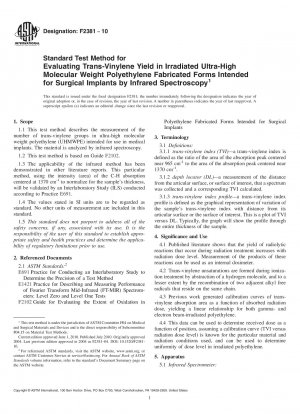ASTM F2381-10
Standard Test Method for Evaluating Trans-Vinylene Yield in Irradiated Ultra-High-Molecular-Weight Polyethylene Fabricated Forms Intended for Surgical Implants by Infrared Spectroscopy
- Standard No.
- ASTM F2381-10
- Release Date
- 2010
- Published By
- American Society for Testing and Materials (ASTM)
- Status
- Replace By
- ASTM F2381-19
- Latest
- ASTM F2381-19
- Scope
Published literature shows that the yield of radiolytic reactions that occur during radiation treatment increases with radiation dose level. Measurement of the products of these reactions can be used as an internal dosimeter.
Trans-vinylene unsaturations are formed during ionization treatment by abstraction of a hydrogen molecule, and to a lesser extent by the recombination of two adjacent alkyl free radicals that reside on the same chain.
Previous work generated calibration curves of trans-vinylene absorption area as a function of absorbed radiation dose, yielding a linear relationship for both gamma- and electron beam-irradiated polyethylene.
This data can be used to determine received dose as a function of position, assuming a calibration curve (TVI versus radiation dose level) is known for the particular material and radiation conditions used, and can be used to determine uniformity of dose level in irradiated polyethylene.
1.1 This test method describes the measurement of the number of trans-vinylene groups in ultra-high molecular weight polyethylene (UHMWPE) intended for use in medical implants. The material is analyzed by infrared spectroscopy.
1.2 This test method is based on Guide F2102.
1.3 The applicability of the infrared method has been demonstrated in other literature reports. This particular method, using the intensity (area) of the C-H absorption centered at 1370 cm-1 to normalize for the sample’s thickness, will be validated by an Interlaboratory Study (ILS) conducted according to Practice E691.
1.4 The values stated in SI units are to be regarded as standard. No other units of measurement are included in this standard.
1.5 This standard does not purport to address all of the safety concerns, if any, associated with its use. It is the responsibility of the user of this standard to establish appropriate safety and health practices and determine the applicability of regulatory limitations prior to use.
ASTM F2381-10 Referenced Document
- ASTM E1421 Standard Practice for Describing and Measuring Performance of Fourier Transform Mid-Infrared (FT-MIR) Spectrometers: Level Zero and Level One Tests
- ASTM E691 Standard Practice for Conducting an Interlaboratory Study to Determine the Precision of a Test Method
- ASTM F2102 Standard Guide for Evaluating the Extent of Oxidation in Polyethylene Fabricated Forms Intended for Surgical Implants
ASTM F2381-10 history
- 2019 ASTM F2381-19 Standard Test Method for Evaluating Trans-Vinylene Yield in Irradiated Ultra-High Molecular Weight Polyethylene Fabricated Forms Intended for Surgical Implants by Infrared Spectroscopy
- 2010 ASTM F2381-10 Standard Test Method for Evaluating Trans-Vinylene Yield in Irradiated Ultra-High-Molecular-Weight Polyethylene Fabricated Forms Intended for Surgical Implants by Infrared Spectroscopy
- 2004 ASTM F2381-04 Standard Test Method for Evaluating Trans-Vinylene Yield in Irradiated Ultra-High-Molecular-Weight Polyethylene Fabricated Forms Intended for Surgical Implants by Infrared Spectroscopy
